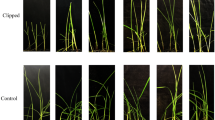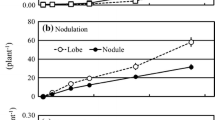Abstract
Little is known regarding production and function of endogenous jasmonates (JAs) in root nodules of soybean plants inoculated with Bradyrhizobium japonicum. We investigated (1) production of jasmonic acid (JA) and 12-oxophytodienoic acid (OPDA) in roots of control and inoculated plants and in isolated nodules; (2) correlations between JAs levels, nodule number, and plant growth during the symbiotic process; and (3) effects of exogenous JA and OPDA on nodule cell number and size. In roots of control plants, JA and OPDA levels reached a maximum at day 18 after inoculation; OPDA level was 1.24 times that of JA. In roots of inoculated plants, OPDA peaked at day 15, whereas JA level did not change appreciably. Shoot dry matter of inoculated plants was higher than that of control at day 21. Chlorophyll a decreased more abruptly in control plants than in inoculated plants, whereas b decreased gradually in both cases. Exogenous JA or OPDA changed number and size of nodule central cells and peripheral cells. Findings from this and previous studies suggest that increased levels of JA and OPDA in control plants are related to senescence induced by nutritional stress. OPDA accumulation in nodulated roots suggests its involvement in “autoregulation of nodulation.”






Similar content being viewed by others
Abbreviations
- AOC:
-
Allene oxide cyclase
- AON:
-
Autoregulation of nodulation
- AOS:
-
Allene oxide synthase
- DM:
-
Dry matter
- JA:
-
Jasmonic acid
- JAs:
-
Jasmonates
- LOX:
-
Lipoxygenase
- MeJA:
-
Methyl-jasmonate
- OPDA:
-
12-Oxophytodienoic acid
References
Andrade A, Vigliocco A, Alemano S et al (2005) Endogenous jasmonates and octadecanoids in hypersensitive tomato mutants during germination and seedling development in response to abiotic stress. Seed Sci Res 15:309–318
Armengaud P, Breitling R, Amtmann A (2004) The potassium-dependent transcriptome of Arabidopsis reveals a prominent role of jasmonic acid in nutrient signaling. Plant Physiol 136:2556–2576
Burton J, Martinez C, Curley R (1972) Methods of testing and suggested standards for legume inoculants and preinoculated seed. Nitragin Corporation, USA
Castro G, Kraus T, Abdala G (1999) Endogenous jasmonic acid and radial cell expansion in buds of potato tubers. J Plant Physiol 155:706–710
Cenzano A, Vigliocco A, Kraus T et al (2003) Exogenously applied jasmonic acid induces changes in apical meristem morphology of potato stolons. Ann Bot 91:917–921
Evans JR (1989) Photosynthesis and nitrogen relationships in leaves of C3 plants. Oecologia 78:9–19
Ferguson BJ, Indrasumunar A, Hayashi S et al (2010) Molecular analysis of legume nodule development and autoregulation. J Integr Plant Biol 52(1):61–76
Fliegmann J, Furtwängler K, Malterer G et al (2010) Flavone synthase II (CYP93B16) from soybean (Glycine max L.). Phytochemistry 71:508–514
Hause B, Schaarschmidt S (2009) The role of jasmonates in mutualistic symbioses between plants and soil-born microorganisms. Phytochemistry 70:589–1599
Hayashi S, Gresshoff PM, Kinkema M (2008) Molecular analysis of lipoxygenases associated with nodule development in soybean. Mol Plant Microbe Interact 21:843–853
He Y, Tang W, Swain JD et al (2001) Networking senescence-regulating pathways by using Arabidopsis enhancer trap lines. Plant Physiol 126:707–716
Hirai MY, Fujiwara H, Awazuhara M et al (2003) Global expression profiling of sulfur-starved Arabidopsis by DNA macroarray reveals the role of O-acetyl-l-serine as a general regulator of gene expression in response to sulfur nutrition. Plant J 33:651–663
Johansen DA (1940) Plant Microtechnique. McGraw-Hill Book Company Inc, New York, p 523
Kinkema M, Gresshoff PM (2008) Investigation of downstream signals of the soybean autoregulation of nodulation receptor kinase GmNARK. Mol Plant Microbe Interact 21:1337–1348
Mabood F, Smith DL (2005) Pre-incubation of B. japonicum with jasmonates accelerates nodulation and nitrogen fixation in soybean (Glycine max L.) at optimal and suboptimal root zone temperatures. Plant Physiol 125:311–323
Mabood F, Zhou X, Lee KD et al (2006a) Bradyrhizobium japonicum preincubated with methyl jasmonates increases soybean nodulation and nitrogen fixation. Agron J 98:289–294
Mabood F, Souleimanov A, Khan W et al (2006b) Jasmonates induce Nod factor production by B. japonicum. Plant Physiol Biochem 44:759–765
Mabood F, Zhou X, Lee KD et al (2006c) Methyl jasmonate, alone or in combination with genistein, and B. japonicum increases soybean (Glycine max L.) plant dry matter production and grain yield under short season conditions. Field Crops Res 95:412–419
MacKinney G (1941) Absorption of light by chlorophyll solutions. J Biol Chem 140:315–322
Martens S, Mithöfer A (2005) Flavones and flavone synthases. Phytochemistry 66:2399–2407
Mohammandi M, Karr A (2003) Induced lipoxygenases in soybean root nodules. Plant Sci 164:471–479
Nakagawa T, Kawaguchi M (2006) Shoot-applied MeJA suppresses root nodulation in Lotus japonicus. Plant Cell Physiol 47(1):176–180
Nikiforova V, Freitag J, Kempa S et al (2003) Transcriptome analysis of sulfur depletion in Arabidopsis thaliana: interlacing of biosynthetic pathways provides response specificity. Plant J 33:633–650
O’Brien TP, Mccully ME (1981) The study of plant structure: principles and selected methods. Termacarphi PTY Ltd, Melbourne, p 339
Pauwels L, Inzé D, Goossens A (2009) Jasmonate-inducible gene: what does it mean? Trends Plant Sci 14(2):87–91
Perticari A, Parra R, Balatti P, Fiqueni M, Rodriguez Caceres E (1996) Selección de cepas de Bradyrhizobium japonicum, B. elkanii y Sinorhizobium fredii para la inoculación de soja. In: Memorias de la XVIII Reunión Latinoamericana de Rizobiología. Santa Cruz de La Sierra, Bolivia, pp 103–104
Porra RJ (2002) The chequered history of the development and use of simultaneous equations for the accurate determination of chlorophylls a and b. Photosynth Res 73:149–156
Rosas S, Soria R, Correa N et al (1998) Jasmonic acid stimulates the expression of nod genes in Rhizobium. Plant Mol Biol 38:1161–1168
Rossato L, MacDuff JH, Laine P et al (2002) Nitrogen storage and remobilization in Brassica napus L. during the growth cycle: effects of methyl jasmonate on nitrate uptake, senescence, growth, and VSP accumulation. J Exp Bot 53:1131–1141
Seltmann MA, Krischke M, Müller MJ et al (2010) Jasmonates regulate stress-induced senescence but not natural senescence. Plant Physiol 152:1940–1950
Sembdner G, Parthier P (1993) The biochemistry and the physiological and molecular actions of jasmonates. Annu Rev Plant Physiol Plant Mol Biol 44:569–589
Seo HS, Song JT, Cheong JJ et al (2001) Jasmonic acid carboxyl methyltransferase: a key enzyme for jasmonate-regulated plant responses. Proc Natl Acad Sci USA 98:A788–A793
Seo HS, Li J, Lee S-Y et al (2007) The hypernodulating nts mutation induces jasmonate synthetic pathway in soybean leaves. Mol Cells 24:185–193
Sun J, Cardoza V, Mitchell DM et al (2006) Crosstalk between jasmonic acid, ethylene and Nod factor signaling allows integration of diverse inputs for regulation of nodulation. Plant J 46:961–970
Takahashi K, Fujino K, Kikuta Y et al (1994) Expansion of potato cells in response to jasmonic acid. Plant Sci 100:3–8
Theodoulou FL, Job K, Slocombe SP et al (2005) Jasmonic acid levels are reduced in COMATOSE ATP-binding cassette transporter mutants. Implications for transport of jasmonate precursors into peroxisomes. Plant Physiol 137:835–840
Vernon LP (1960) Spectrophotometric determination of chlorophylls phaeophytins in plant extracts. Ann Chem 32:1144–1150
Wasternack C, Kombrink E (2010) Jasmonates: structural requirements for lipid-derived signals active in plant stress responses and development. ACS Chem Biol 5:63–77
Yoon JY, Hamayun M, Lee SK et al (2009) Methyl jasmonate alleviated salinity stress in soybean. J Crop Sci Biotechnol 12(2):63–68
Zdyb A, Demchenko K, Heumann J, Mrosk C, Grzeganek P, Göbel C, Feussner I, Pawlowski K, Hause B (2011) Jasmonate biosynthesis in legume and actinorhizal nodules. New Phytol 189:568–579
Zhao S, Qi X (2008) Signaling in plant disease resistance and symbiosis. J Integr Plant Biol 50:799–807
Acknowledgments
This work was supported by grants from SECYT-UNRC and ANPCYT to G.A. The authors thank Dr. S. Anderson for English editing.
Author information
Authors and Affiliations
Corresponding author
Additional information
Communicated by Ursula Priefer.
Rights and permissions
About this article
Cite this article
Costanzo, M.E., Andrade, A., del Carmen Tordable, M. et al. Production and function of jasmonates in nodulated roots of soybean plants inoculated with Bradyrhizobium japonicum . Arch Microbiol 194, 837–845 (2012). https://doi.org/10.1007/s00203-012-0817-y
Received:
Revised:
Accepted:
Published:
Issue Date:
DOI: https://doi.org/10.1007/s00203-012-0817-y




